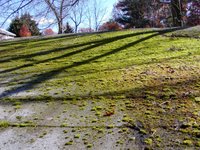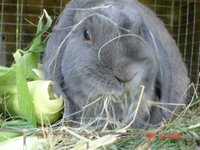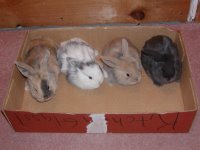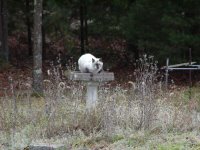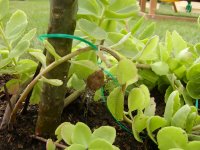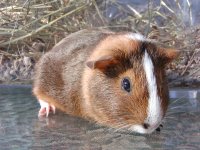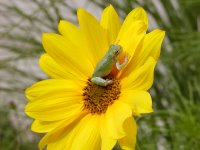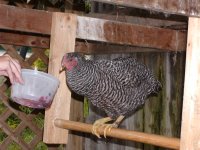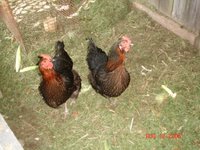Tuesday, December 26, 2006
Diverticulitis
I've been battling this disease since September 2006 - here it is December 2006 and currently on my 6th relapse, which occurs several days or so after I complete my cycle of antibioitics. I've taken several different types of antibiotic these last 4 months, anywhere from 7, to 10 to 13 days worth and in some relapse more than one type at a time - Ciprofloxacin, Metronidazole (known as Flagyl and NASTY!), Augmentin, Levofloxacin.
This last relaps landed me in the hospital for 4 days and 3 nights, which is my second stay in the hospital as a result of this disease. Although, diverticulitis was involved and did become irritated again the bigger problem was something the doctor's were referring to as "C-Diff" or Clostridium difficile colitis. Things appear to be under control at this point and I'm back on the Flagyl, as well as a Probiotic to help maintain the natural balance of organisms (microflora) in the intestines.
Since September I've had 4 cat scans, as well as a colonoscopy not to mention all the poking, prodding and needle sticks...Oh, almost forgot I had my prostate checked too, at least that's what the doctor told me. It felt like he was checking my tonsils... I've also become a regular in the emergency room. I am down 35lbs to 150lbs, which I haven't seen since my High School days, yikes! Also, in this time I have had to watch what I eat and have not been able to eat the things (junk) that I normally would - no alcohol, no pizza, no chips, no crackers, no nuttin good and I am not too happy about this, especially around the holiday's.
Keep your fingers crossed and hopefully the surgery will be a success and I will be on the road to recovery soon.
Here is some information on Diverticulitis from emedicine and some from WebMD -Diverticulitis
Shadows
Sunday, December 17, 2006
Piggy, Piggy, Piggy...
Here is a picture of the new piglets that my friend recently purchased. There are over 15 here but I was unable to get an exact count - you try to count them as they're darting in and out, climbing over each other and wrestling for food.
The males have already been 'fixed' and will go to market when they're at the right size. The females will stay and be bred when old enough to replenish the stock.
This is only one of 3 pig pens. The other 2 have adult pig; pigs that are well over 400lbs in size. The females in these pens are used for breeding and the males - except for the one lucky guy that's kept for breeding, will go to market. Many of the sows in these pens have already been bred and are due in early spring.
Saturday, December 16, 2006
LaMancha (Goats)
He's added a number of new animals to his menagerie since I last visited; beautiful show chickens (bantams) - some pairs and some trios, call ducks, 20+ pig - some new purchases and some from new litters and 3 female LaMancha goats (pictured).
As you can see from the picture these goats are unique in that they have no ears, which is a distinguishing feature. All three of these goats are pregnant and due in early spring. The picture shows three generations; the grandmother is on the right, her daughter in the center and her daughters daughter (granddaughter) on the left.
These three girls are extremely friendly, have a wonderful disposition and love to be involved with whatever your doing. They're already producing milk and need to be milked daily, which my friend is glad and eager to do. He enjoys the taste and say's you can't beat fresh goat milk, not to mention how good it is for you. We can't wait till the babies arrive, as they're sure to be adorable.
History of the LaMancha Dairy Goat
Monday, December 11, 2006
Spotted Salamander

Have a gander at what my dad came across just the other day! Keep in mind that it's December here in New England, so a find like this now is extremely unusual but let me clarify...
It's not that this little guy was on a walk-about. My dad was actually de-installing his sub pump from just outside the basement so it wouldn't freeze. The pump sits in a deep hole that was dug just underneath a grate and crushed stones. Well, this guy had chosen this same place to hibernate for the long, cold winter. Perhaps he was drawn to the cold, dark and damp hole. I didn't want to handle him, so I didn't measure him but I would guess he was close to 7" long.
My dad kept him outside in a bucket, so not to wake him from his winter nap, until we were able to visit. Emilie was excited and refers to him as a lizard. We took a number of pictures before releasing. I placed him near the edge of the wood, under several planks of wood and covered him with some additional cold mulch. Hopefully this will suit him well and keep him safe until March when he'll awaken and make his way to the vernal pool next door for some nookie!!
My dad finding this guy is reassuring to know that they're still out there and doing fine. It also brings back some good memories of when I was young. Come the first full moon in March, ideally on a raining night, we'd put on our rubber boots, grab a flash light and head to the swap in the hopes of finding and seeing these guys on their migration.
I think I will introduce Emilie to this come March 2007.
Thursday, December 07, 2006
It's Begining To Look A Lot Like Christmas
JoAnne and Emilie did an awsome job setting up and decorating the ole family Christmas tree - wouldn't you all agree? Just waiting to be loaded with present...
Emilie's at that age now where she is completely taken by Christmas and all that goes with it. It gives me a renewed appreciation of how special this time of the year really is and just how lucky and fortunate a person (boyfriend, father & son) I am.
Wednesday, December 06, 2006
Jack-O-Lantern 2006
Friday, December 01, 2006
Woolly Bear Caterpillar
I was out in the yard on Thanksgiving morning cleaning out the chicken coop - well it's not really a coop just yet, more like a pen but it needed cleaning regardless so let's not split hairs here OK? Anyway, as I was pitch-forking the bedding out I came across a nice fat Woolly Bear caterpillar. We'd seen a number of them as the fall approached but never this late in the year. I guess the mild New England weather has kept these dudes, as well as other insects and critters, on the move and from going into a full hibernation.
I scooped this dude up and placed him in my jacket pocket for safe keeping and not to lose him - I didn't squish him either AND I actually remembered he was there too! Anyway, as I typically do, this dude was going to Emilie. Let me tell you Emilie eye's lit up when she saw him and screamed, "a woolly bear". She was in her glory with this critter. He was relegated to a Winnie the Pooh dixie cup for several days, which was it's safe haven from when Emilie wasn't holding him and playing with and making him do tricks, stunts etc. She came to us with the boot from one of her dolls - a 'hootchy mama' boot if you will. You know the long, knee high black boots...anyway guess where the woolly bear was 'stuck'?!?! Between you and me he wasn't stuck, he simply found a safe place to stay hidden. Eventually he made his way out and Emilie was once again in her glory. We let him go just the other day, much to his relief and looking forward to finding a safe place to winter.
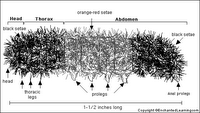
Friday, November 10, 2006
Roof Moss?!
Here are a couple interesting pictures of moss growing on a shed roof...
I was at my dad's house the past Saturday to get his yard cleaned up and put to bed for the winter. The grass needed one last cutting but before that could happen the leaves needed to be picked up, the flower pots needed to be emptied and put away, frost killed annuals needed to be pulled and the gutters needed to be cleaned on both the house and the shed.
I used my 38" lawn sweeper to pick up as many leaves as possible. Although this is a valuable tool, it fills up too quickly with leaves and it did just that time and time again. I must have emptied that over 30 times! Once I had the majority of the leaves up it was then time to use the mower and bag the remaining ones. Once again, the leaves filled the mower bag too quickly and needed to be emptied over and over and over. Anyway, I am happy to say that the majority of the leaves, at that time anyway, were picked up and the grass cut nice and low.
I then moved to cleaning the gutters. I use a hand-held Craftsman leaf blower for this task - it works GREAT! The house gutters were not too bad at all - there are no large trees close to the house so their leaves have little effect. However, the shed roof is a different story, as it sits beneath several tall maples. Needless to say it doesn't take too long for the gutters to fill and become clogged.
Well, as I climbed the ladder to get on the roof I was amazed to see the back of the roof, which is not visible from the house and day to day activity, was covered with moss! It looked like the roof was covered with a nice green carpet. This is NOT a good thing to have happening, not at all. The moss retains moisture, which does damage to the shingles, as well as the added weight. We need to understand the cause of this so we can prevent it from happening again but we also need to figure out a way to kill the moss and remove it. I used a snow shovel and was able to scrap off and remove some but most remains. I am thinking of spraying a water and bleach solution on it to kill the moss...just an idea, we'll see.
Anyway, the gutters have been cleaned and the yard put to bed - come on ole man winter!
P.S. These pictures were taken before I cleaned the roof and gutters. All the leaves, sticks and 'stuff' have been removed - it looks better. I do good work, after all why do something unless you're going to do it right, right!
Wednesday, November 01, 2006
Blue Bird

This picture was taken in the early Spring. You can see him perched on the fence in our backyard. He didn't stay too long at all and honestly I am not sure how I was even able to take this picture of him but I did and here's the proof!
This magnificent little fellow dropped in and surprised the day-lights outta me. Although we live in what was once known as a farm type community that was a long time ago. As I imagine with most communities today construction is constant and the face of the towns are changing. As a result the open spaces are becoming harder to find, so it was VERY surprising to see this dude visiting our back yard. Needless to say I was pretty excited at this sighting. JoAnne was not as moved and didn't fully understand my excitement but played along just the same - she's a peach!
I was hoping he'd decide to choose one of our bird houses and stay but we only saw him that one time. Perhaps, he'll visit us again next Spring and hopefully stay longer. Time will tell...
Tuesday, October 31, 2006
Jack
Jack is a handsome grey male (buck) Holland Lop rabbit. He was named by our daughter Emilie after a day care classmate of hers.
We bought Jack from a young kid a few towns over from us. We saw his, "Rabbits for Sale" sign at the end of his driveway and pulled in. We were in need of a Holland Lop buck, as our previous buck had passed away a couple months earlier. As fate (I guess) would have it he had only one Lop and it turned out to be a breeding age buck, Jack. It's funny how that stuff works...
We've had Jack now for about 18 months now. He has a great personality and a friendly disposition AND he knows his away around the bedroom, if you know what I mean wink, wink. He'll get to strut his stuff with the ladies come the first of the year, as we'll be breeding the doe's in preparation of Easter.
We now have 4 rabbits; Jack and three Holland Lop females (doe's). We just relocated all 4 from their outside cages to their inside cages in our garage. Although it's still chilly in the garage they're fine. The biggest concern with keeping rabbits outside during the winter is not necessarily the cold but rather the wind. With them being inside it's easier for us to take care of them and the get more attention and lovin.
Here is a picture of Jack's babies from his first litter. These 4 adorable bunnies were born Tuesday, April 4, 2006. They all went to nice homes and are doing great today!
Monday, October 23, 2006
Crackers
Meet Crackers
Crackers is a 16+ year old cat. She was one of two pairs of twins; one set siamese in color and markings and the other set all black. We kept her and found homes for the other three. One of the black kittens was taken by a close neighbor and is still alive today too. I don't recall who took the other two, so I am not sure if they're still alive.
Thursday, October 12, 2006
Katydid
The pictures here are of a little guy we found hangin around our butterfly and dahlia garden. As you can see from the second picture he's one tough dude to spot. If you didn't know he was there you'd miss him 10 times out of 10 and you'd go hungry. Oh by the way, our dahlia's were fantastic this year, as you can see here!
KATYDID common name of certain large, singing, winged insects related to the grasshopper and cricket family (Tettigoniidae). Katydids are typically green or, occasionally, pink and range in size from 1 1/4 to 5 in. long. Katydids are nocturnal and arboreal; they sing in the evening. The males have song-producing, or stridulating, organs located on their front wings. The females chirp in response to the shrill song of the males, which supposedly sounds like "katy did, katy didn't," hence the name. The song serves a function in courtship, which occurs in late summer. The female lays eggs in the ground or in plant tissue; the eggs hatch in spring. Newly hatched katydids resemble the adults except for their smaller size and lack of wings. Katydids are common in the Eastern United States and are also found in the tropics.There are some 4,000 species of katydids in the world. They feed on the leaves, stems, flowers and fruits of a variety of plants. They also form an important part of the diet of many animals higher up in the food chain.
The true katydids of Eastern North America are considered great singers; each species has its own repetitive song, which is produced only at night. Many species resemble leaves, which aid in there ability to hide from predators. They are powerful jumpers; many species do not fly but merely flutter their wings during leaps.
Do you see him?!
How bout now, anything?
Look closer. He's there; I wouldn't tease you like that...
Monday, October 09, 2006
Mr. Eastern American Toad

Here are a couple picture of one that I caught at work, during lunch just the other day. He spent the afternoon in my desk drawer, in a styrofoam cup until I got home. Once again, we kept her for the day and released her in the back yard. Here she is sitting on a Sedum plant. She had no problems posing for pictures, just look at her boasting full of confidence...
One of the benefits of having these amphibians hangin in your back yards is that they eat a variety of invertebrates, especially ants, beetles, slugs, spiders and mites. The eating of the 'slugs' is what I am most grateful of. We have too many slugs in our yard, more often found on my hosta plants and raspberries plants and a general nuisance causing more damage then good.

Some people call these common creatures "hop toads", and they do indeed move about in short hops rather than long leaps. Most toads are brown, but their colour can range from grey-brown to red-brown. Breeding males have a black throat and are smaller than females. Toads emerge from hibernation and fill the night air with long, trilling calls in May and June. Strings of 6 to 12 thousand eggs are laid in warm shallows; the small dark polliwogs develop rapidly and transform into miniature toads by September. Toads are among the last amphibians to hibernate each fall, and may be seen into late November.
Toads have a dry, "warty" skin. The "warts" are glands that contain a white sticky substance intended to turn away predators biting the toad. Handling toads will not cause warts in people. Some people say toads have the most "character" of all the amphibians. They are the most commonly seen frog in towns because they frequent backyard gardens and front lawns, often staying in one area all summer. Their hind feet have special small knobs for shoving soil aside so they gradually sink and bury themselves.
Friday, October 06, 2006
Abutilon (Ab yew til on)
Abutilon is a genus of about 150 species and many more varieties, with common names like; Flowering Maple, Indian Mallow, Parlor Maple 'Souvenir de Bonn'. Flowering Maples are handsome tropical shrubs in the mallow family with large, maple-like leaves. They have a continuous display, April through November, of pendant, waxy, bell-shaped flowers. In climates with mild winters abutilons can become large shrubs, quickly growing to 4'-8' tall. They are excellent plants for containers, where they typically grow 3'-4' high. In colder climates they can be brought indoors for the winter. Abutilons are indispensable for attracting hummingbirds. In areas with hot summers abutilons require some shade and regular watering.
Abutilon pictum 'Souvenir de Bonn' has pretty orange flowers, but the main feature of this variety is its cream-edged leaves. It is a vigorous, erect small tree to perhaps 10' in all dimensions. Typically evergreen, with all or nearly all the leaves showing the variegation. Flowers are pendant, bowl-shaped, and soft orange with green striations. 'Souvenir de Bonn' needs a zone 9 or 10 climate, or shelter indoors during the cold months. It does well in a pot when pruned back heavily.
Thursday, September 28, 2006
Tuesday, September 26, 2006
Eastern Black Swallowtail

Stage 3:

The Black Swallowtail, a.k.a., Parsnip Swallowtail, Eastern Black Swallowtail, and Parsley Worm, is one of the easiest butterflies to attract to your garden. The female will lay her eggs on virtually any member of the carrot family (Apiaceae), wild or cultivated, which includes favorites such as Parsley, Dill and Fennel (Foeniculum spp.), which they all feed on.
Both male and female Eastern Black Swallowtails are bluish-black with yellow spots on the wings. They also have two orange eyespots with black dots in the middle.
The male has a yellow band on the hind wings with a blue cloud under it. The female has a row of yellow dots above a blue band. It's easiest to remember that males have more yellow, and females have more blue.
This animal will overwinter in the chrysalis (pupal stage), meaning it won't hatch into an adult until Spring but may be seen flying as early as the end of April and as late as the end of October. The adult will drink nectar from many different flowers, including milkweeds, thistles, Red Clover, and Purple Coneflower.
The Eastern Black Swallowtails will search open spaces, such as meadows, gardens, banks of streams and ponds, marshes, and roadsides in search of nectar and mates. They usually flutter around, but when they are disturbed they fly straight.
This butterfly is a mimic, which means its pattern copies another animal. Its cousin, the Pipevine Swallowtail is poisonous to many predators. By copying the Pipevine Swallowtail, the Eastern Black Swallowtail gains protection from predators, even though it is not poisonous. This animal is most often eaten as a caterpillar.
Quiz - Read the definitions, then label the diagram below:
Definitions
- Abdomen - The abdomen is the segmented tail area of an insect that contains the heart, Malpighian tubules, reproductive organs, and most of the digestive system.
- Antenna - An antenna is a sensory appendage that is attached to the head of adult insects. Antennae are used for the sense of smell and balance. Butterflies have two antennae with clubs at the end.
- Compound Eye - Insect compound eyes are made up of many hexagonal lenses.
- Fore wing - The fore wings are the two upper wings.
- Head - The head is the part of the insect that contains the brain, two compound eyes, the proboscis, and the pharynx (the start of the digestive system). The two antennae are attached to the head.
- Hind wing - The hind wings are the two lower wings.
- Leg - All adult butterflies have six legs. The two forelegs of some butterfly species are tiny.
- Proboscis - Adult butterflies sip nectar and other liquids using a spiral, straw-like proboscis located on their head.
- Thorax - The thorax is the body section between the head and the abdomen. The legs and wings attach to the thorax.
Sunday, September 24, 2006
Raising a Greenhouse
Well, we didn't actually raise the greenhouse, not this past weekend anyway, we finally covered it (again)!
When we first installed the greenhouse back in 1998 or 1999, we covered it with two layers of 6mil plastic. This was a four year plastic that happened to last almost six years - I guess because we doubled it. However, the New England weather took it's toll - of course the wild turkeys that decided to roost on the ridge didn't help either but rather helped it's demise along by sinking their claws through the plastic to grip the ridge bar. Covering it back then was a challenge and I was younger and a tad bit lighter, svelte, but let's not get into specifics and waist sizes...
The greenhouse has sat uncovered now for a couple years, not being used. All the 'stuff' that was inside still sitting where it was when it was covered, only now it's ruined and useless. The goal now is to get the ends built, the woodstove installed, clean ALL that 'stuff' out , get the plants in before the first New England frost and get the greenhouse back up and running.
How bout some specs on this here greenhouse:
48' long
30' wide
12' floor to ridge
We purchased a new 100' roll of 6mil plastic and yes, it's quite heavy. Once again we rolled it out (on the neighbors lawn) and cut it in half - it went on it two pieces. Once on, the ends needed to be secured. Now this might sound failrly straight forward, however, there are approximately 50 bolts that need to installed on each end. The problem here is that each bolt needs to cut through 2 layers of plastic to get a grip on the threads. The bolts do not have points on the end but rather they're flat, also short. Anyway, we got it done despite it being on the windy side too and it only took about 5 hours.
At one point this entire greenhouse was full of beautiful flowers with a sea of colors. I can't tell you how satisfying it is to finally see it covered and on the road to being used again. The anticipation will be well worth waiting for!
Here are ‘before and after’ pictures:
Before:
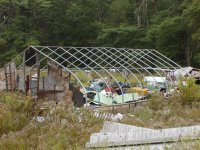
After:

Friday, September 22, 2006
Orb Weaver - UPDATE
It was only a couple days later that we discovered her, not too far from where we let her go, in a brandy new web she built just waiting for dinner to arrive. Here is a picture of her -
I spent this past Saturday in the yard planting some new perennials, splitting and transplanting some daylilies, etc. I've had this one Sedum plant that's been confined to a pot all summer long. It was planted along with a small Plumeria cutting. I should have separated the two in the spring but it didn't happen. So with the pending arrival of fall/winter I thought now would be a good time to get the two spit, the Sedum in the ground and the Plumeria in the house.
There are two reasons why this plan didn't occur; first, there was almost no dirt left in the pot when I removed the plants - it was all roots, root-bound. Splitting the two plants would have been difficult under these conditions but I was ready for the challenge. Secondly, and the main reason, I found this hanging amongst the two plants, as a result I am sacrificing the Plumeria plant to Mother Nature (we have two others) -
I believe this papery sack is housing over a thousand eggs that were laid by our Black and Yellow lady. This Sedum/Plumeria potted plant was in the area where we released her. Emotions are mixed here, on one hand we're proud pending parents, but on the other hand we're sadden because after laying the egg, the spider dies, which may also explain why we have not see her in quite some time now...plus we have our work cut out for us. How in the world are we going to come up with one thousand names, GRIKEY?!
The baby spiders hatch from their eggs in the fall, but they stay inside the sac through winter, so we'll be keeping a close eye come Spring to see just what emerges. Actually, I may now move this plant someplace closer to the house, where there is a better chance of the young sticking around our flower gardens versus venturing elsewhere.
Oh the anticipation, stay tuned...
Friday, September 15, 2006
So Long Old Friends...
Baby Snappity was the first to scoot off, she didn't waste any time. Snappity followed right behind but appeared to be somewhat reluctant to go, as she kept coming back and poking her head out of the water. Perhaps she was looking for permission or a nodding 'take care'. Painty was pulled completely into her shell and would not move. We ended up moving back a good ways so she couldn't see us. This worked as she slowly poked her head out, then her front feet and then swish off she went. All we saw of her as she bolted was bubbles on the surface of the water.
I was a little concerned for Baby Snappity. When we first arrived at the rivers edge there was a beautiful Grey Heron not more than 50 feet away from us. Now Baby Snappity is the perfect size for one of these bird to eat - a Turtle McNugget if you will, and actually the same size as a McDonald's McNugget. In my protective parent mode I tossed a rock in the Heron's direction, which landed with a plump a few feet away, and sent her flying off squawking something.
Good luck to them all and thanks for the memories...
Here is an interesting picture of Snappity and Baby Snappity - from their view point. Sorry, we don't have a picture of me taking a picture of them - which would be pretty funny.
Wednesday, September 13, 2006
Meet Riley
Just the other day, out of the blue, Emilie asked if she could have a guinea pig someday. The very next day there was a posting on the bulletin board at work, "Guinea Pigs for Sale". How could I refuse with a coincidence like that?! It's karma I tell yeah. Needless to say Emilie got her pet guinea pig and I need my head examined...
Da Plane

It was a beautiful day as you can see and I was in the backyard vacuuming my pool, in the process of closing it up for the winter, when JoAnne says, "Emie look". Low and behold this incredible sight!
Here it is Sunday September 10th, one day away from the five year anniversary of 9/11 and this bird is flying over our area, so you can just image what we're thinking. To boot, which only fueled our imagination, the night before there was a 'Breaking News Story' on the local news about a security scare near the LNG Facility in Everett, MA about a Suspicious Truck Found Nearby.
Now I bet you're wondering how I got these pictures and if I walk around with a camera in my back pocket. Well, the answer is that this was the second pass for this plane, which came about 20 minutes after the first. This time I just happened to be in the kitchen, which was where the camera was too. Also, I will never tell or admit if I carry a camera in my back pocket.
Come to find out this plane was a part of the New England Patriots season opening pre-game festivities - mystery solved. The stadium is where the Pat's play is not too far from where we live.
Oh, and the Pat's won 19-17 over the Bills with a safety...GO PATS GO!
Friday, September 08, 2006
Mr. Pickerel Frog
The pickerel frog is a medium sized frog being about 3 inches in body length with smooth-skin. Adults are tan or brown (never green) with four to five pairs of squarish brown spots. They have complete light gold dorsolateral ridges down the back. The belly is plain white. There is a distinctive yellowish wash in the groin areas and the thighs. There are brown tiger stripes on the hind legs.
Pickerel Frogs are similar to Northern Leopard Frogs in general size and appearance. Unlike leopard frogs, pickerel frogs are always brown (leopard frogs, except plains leopards, may be green or brown), have square spots arranged in pairs on the back, and a yellowish wash on the thighs (all leopard frogs usually have a greenish wash).
Pickerel frogs breed in spring (late April, May, and June). The males call is a deep snore. It is shorter and higher pitched than the northern leopard frog’s call and is usually not followed by a chuckle as in leopard frogs. They call from the shore or from underwater in shallow portions of the wetland. Females lay 2,000 to 3,000 eggs. The tadpoles transform in two or three months.
Side-by-side comparison of a Pickerel Frog vs a Leopard Frog
Carrot, Egg or Coffee Bean?
A young woman went to her mother and told her about her life and how things were so hard for her. She did not know how she was going to make it and wanted to give up. She was tired of fighting and struggling. It seemed as one problem was solved, a new one arose. Her mother took her to the kitchen. She filled three pots with water and placed each on a high fire. Soon the pots came to boil. In the first she placed carrots, in the second she placed eggs, and in the last she placed ground coffee beans. She let them sit and boil, without saying a word. In about twenty minutes she turned off the burners. She fished the carrots out and placed them in a bowl. She pulled the eggs out and placed them in a bowl. Then she ladled the coffee out and placed it in a bowl.
Turning to her daughter, she asks, "Tell me what you see.""Carrots, eggs, and coffee," she replied. Her mother brought her closer and asked her to feel the carrots. She did and noted that they were soft. The mother then asked the daughter to take an egg and break it. After pulling off the shell, she observed the hard boiled egg. Finally, the mother asked the daughter to sip the coffee. The daughter smiled as she tasted its rich aroma. The daughter then asked, "What does it mean, mother?"
Her mother explained that each of these objects had faced the same adversity: boiling water. Each reacted differently. The carrot went in strong, hard, and unrelenting. However, after being subjected to the boiling water, it softened and became weak. The egg had been fragile. Its thin outer shell had protected its liquid interior, but after sitting through the boiling water, its inside became hardened. The ground coffee beans were unique, however. After they were in the boiling water, they had changed the water.
"Which are you?" She asked her daughter. "When adversity knocks on your door, how do you respond? Are you a carrot, an egg or a coffee bean?
"Think of this: Which am I? Am I the carrot that seems strong, but with pain and adversity do I wilt and become soft and lose my strength? Am I the egg that starts with a malleable heart, but changes with the heat? Did I have a fluid spirit, but after a death, a break-up, a financial hardship or some other trial, have I become hardened and stiff? Does my shell look the same, but on the inside am I bitter and tough with a stiff spirit and hardened heart? Or am I like the coffee bean? The bean actually changes the hot water, the very circumstance that brings the pain. When the water gets hot, it releases the fragrance and flavor. If you are like the bean, when things are at their worst, you get better and change the situation around you. When the hour is the darkest and trials are their greatest, do you elevate yourself to another level? How do you handle adversity?
Are you a carrot, an egg or a coffee bean?
Wednesday, September 06, 2006
Mr. Wood Frog
Here is a picture of a Wood frog we caught at my dads house. As we usually do we took him to our house and enjoyed him for a few days before releasing. This one was quite large, actually one of the largest I've seen, and about as big as they get. My dads house abuts wetlands, as does our so this guy will do just fine in his new surrounds. As a matter of fact it's been 3 weeks since we let him go and he's still out there. I've come across him several times, which is what we were hoping for.
The Wood Frog is most easily recognized by its "robber mask." This black band stretches past both eyes to the eardrums. Wood Frogs also have dorsolateral ridges, two raised lines running down their back and a white belly. Because Wood Frogs spend a lot of time on land, the toes on their front legs are not fully webbed. You can tell males from females by their swollen thumbs
Wood Frogs are very active, and can jump farther than most frogs. To hunt, they can ambush prey, like most frogs. Wood Frogs eat beetles, flies, caterpillars, and other insects; and also spiders, other arthropds, slugs, snails, and worms.
Predators of Wood Frog eggs and tadpoles include leeches, fish, and aquatic insects. Adults are eaten by raccoons, owls, and other animals
When winter's snow is all but gone, leaving ponds and ditches brimming with melt water, wood frogs emerge from hibernation and get right to the business of breeding. Wood frogs (Rana sylvatica) are among the first amphibians to breed each year, starting as early as mid-April.
Note: Boreal Chorus Frogs, Spring Peepers, and the Blue-Spotted Salamander, are a few examples of animals that also breed right after the snow melts.
Wood frogs are truly remarkable little creatures. They are the most widely distributed amphibian in North America, even reaching beyond the Arctic circle! They can mature from egg to transformed frog in as little as 45 days. But perhaps their greatest feat is the unique way in which they spend winter... frozen solid!
Wood frogs are members of a rather exclusive club of vertebrate (back-boned) animals that overwinter on dry land and survive the freezing of their body tissues. World-wide there are only a few species of vertebrates that can tolerate freezing. (Baby painted turtles are the "highest" vertebrates known that can tolerate tissue freezing). Though this feat is "no big deal" to many plants and invertebrates (lots of insects do it), it is a neat trick that enables wood frogs to inhabit many northern environments and frees them from dependence on permanent bodies of water.
The Swallowtail Chrysalis is just one example of an insect that winters in it's pupal or chrysalis stage. Some insects overwinter, and deal with the cold as adults, some as pupae, some as eggs and even some as caterpillars.
Lawn Mowing Machine
As you can see the window shattered into a million pieces. There was glass everywhere, both, inside and out and actually we're still finding pieces inside the truck today, which is almost a month later.
The neighbor was cutting an area where they typically park trucks, so there wasn't much grass left but rather tire ruts and rocks and weeds. Well in his quest to get at and cut the weeds he mowed over a few rocks in the process. The poor mower was taking a beating and we were commenting on his lawn cutting abilities just before this happened, joking about needing to duck. It wasn't two minutes after that when JoAnne noticed what had happened and she wasn't too happy.
Naturally, this particular Ford Explorer model has a 'special' rear window - Murphy's Law right. You'll notice in the picture the warped section in red, just below the wiper blade. This is part of the window and is replaced with the new window as one whole piece. However, this piece does not come painted, it is just primed. Therefore, it needs to be painted to match the color of the vehicle. The one place we took it to for an estimate wants to paint the entire rear door to ensure the colors match - makes sense. However, our insurance company will not pay to paint the entire door - oh they will if we file an official claim, which means paying the deductible. They will, however, as a part of the glass replacement, pay to have that one strip painted at no cost to us.
No matter how you look at it the entire process is a pain in the ass. OH and the replacement window already has some minor issues...
Tuesday, September 05, 2006
Sunday, September 03, 2006
Mr. Grey Tree Frog - UPDATE
We let him go yesterday. We worked on taking some pictures of him, so we placed him on a few different plants. All in all he was a good boy and let us pose him as we wanted.
When done taking pictures we placed him on one of our Autumn Joy Sedum plants - Can you find him in the picture below? You'll have to look hard, as he blends into these particular plants perfectly - he looks like one of the plants leaf.
We placed him on this plant, which had some flies and bees also visiting and gathering nectar from the flowers. We watched him for a few minutes and were amazed to see this little guy line up one of the flies, which was on another flower approximately 4 inches away, and leap. It happened so fast but the end result was the frog had caught himself a snack - a mouth full of fly!
Here is a picture of him sitting in the center of a Sun flower -
Hopefully he'll choose to stay in the area we placed him and continue his rein of insect control and that we'll meet up with him again.
Friday, September 01, 2006
Mark Twain
It's a good thing I don't use profanity, but if I did I would have to agree with Mr. Twain...
Thursday, August 31, 2006
New Honey
She is a Barred Rock pullet; approximately 6 months old. I bought her in the spring to add to our backyard poultry menagerie. She's a good little girl and when alone always singing. However, Lucy and Ethel (pictured below) do not like her and will not leave her alone. They are constantly after her to the point that she can not get any rest. When they are out together, she spends the entire time on her roost. It's gotten to the point now that we either put her out for a few hours before the others, or she goes to bed earlier - this way she has time to eat, drink, scratch and dig before she's driven to roost.
We got our first egg from her the other day, but because of the situation we've yet to receive more.
Actually, now that I think of it Lucy and Ethel are a couple O tough nuts. They let Emilie know in the spring who was boss - one of them chased her and peck the back of her leg. As you can imagine Emilie is not fearful of them. They have also taken a similar approach with JoAnne, which blows my mind because JoAnne tends to them most of the time. JoAnne's not as fearful of them as Emie and will try to give them a "what for" when they come at her but she needs to pay attention none-the-less.
The Barred Rock is one of the all time popular favorites and was developed in New England in the early 1800's by crossing Dominique's and Black Java's. Prolific layers of brown eggs, the hens are not discouraged by cold weather. Their solid plumpness and yellow skin make a beautiful heavy roasting fowl. The narrow, clean barring is desirable in appearance. Their bodies are long, broad, and deep with bred-in strength and vitality. These chickens are often called Plymouth Rocks, but this title correctly belongs to the entire breed, not just the barred variety. Whatever you call them, you can't beat them for steady, reliable chickens. Baby chicks are dark gray to black with some white patches on head and body.
Plant Identification Assistance Needed...
I need your assistance in identifying this plant! This plant was in the landscaping when we bought our house and we've been unable to figure out just what it is. We live in Massachusetts.
It grows similar to a tree - each plant on its own stem and gets approximately 6 feet tall. It seems to spread and create new plants from it's root system. The flowers are a violet and white with a very pleasant aroma. Each leaf is attached directly to the stem and get quite large.
This is an offshoot from where the majority of these plants reside - about 10 feet away, and on the smaller side, as compared to some of the older ones. The flowers on this plant have yet to open.
*** UPDATE, Wednesday September 6, 2006: Well, this plant has FINALLY been identified!! Many thanks to Roberta at UMass Extension. Not only did she identify this plant but her quick and prompt response was refreshing. Within less than 30 minutes of the email I sent her this morning I received her response and answer - amazing.
Too bad this type of response - common courtsey, isn't found more often. Paul Parent you SUCK!
It took me over seven years to identify this plant, so don't expect me to give you the answer here. Do some research, be resourceful, "be the ball" and if after all that you can't figure it out, let me know.
Mr. Grey Tree Frog
Well, not to be out done by the visiting Spring Peeper just the day before, this handsome fellow made an appearance last night. This is a Grey Tree Frog and I came across him hiding perfectly on my garden hose. The hose is grey and green, and so is the frog - camouflaged perfectly. Had I not seen him, he surely would have gotten hurt, even 'croaked', as I was in the process of unwinding the hose.
Emilie ran and got her critter bucket and as usual we brought him in the house. We caught him several bugs incase he got hungry and enjoyed watching him climb all over the sides of the critter bucket. These guys are similar to the Spring Peeper in that they both have large toe pads for gripping when climbing.

Growing up I don't recall ever seeing or catching Grey Tree frogs but I've come across them more and more lately. Last year we found a fairly large one hiding in the hole of a stockade fence post just beside our pool. We didn't bother him and he stayed there for days on end - I guess the eat'n was good there, after all we're always finding all types of insects floating in the pool.

The chameleon of the frog world.
They live wherever they find small ponds, roadside ditches and other pools of standing water. The best habitat is shallow water located close to mixed stands of willows, oaks and pines. The frogs also prefer lots of overhead vegetation, and fallen branches or extensive vegetation along the water’s edge. They often congregate in areas with an abundance of shrubs and vines.
During the day, gray tree frogs hide on or beneath rough tree bark, in hollow trees and on leaves. They tolerate high temperatures quite well, and they're most active during the summer, when humidity is high.
Their remarkable ability to climb or rest on vertical surfaces is the result of a mucous layer produced by toe pad cells. This mucous creates a sticky bond with the vertical surface that’s strong enough to support the frog’s weight.
This frog’s breeding season lasts from early April through July. Males begin calling at breeding sites when night air temperatures reach around 60 degrees. Their calls resemble musical, birdlike or buzzing trills, and the chorus attracts females to the site. The frogs then breed in water.
Afterwards, each female may produce between 700 and 3,800 eggs, and biologists have documented individual frogs producing multiple clutches in a single season. Eggs are light brown, and they measure barely 1/25-inch in diameter. After they are deposited, the eggs attach to floating vegetation in clumps of 30 to 40 eggs. They hatch in only four or five days, and the tadpoles completely metamorphose within two months. Young frogs typically stay near the breeding site for the remainder of summer.
Tuesday, August 29, 2006
Mr. Spring Peeper


One of the first true signs of spring in New England and nearby areas is the evening calling of the Spring Peepers
Spring Peepers live in wooded areas where there is water. Usually they are near marshes, ponds, streams, or vernal pools. Spring Peepers need the water to lay eggs. This is also where they mate. Spring Peepers are nocturnal, so they are most active at night.
Male peepers call the females at night in the spring. Each call is a high-pitched whistle, but many peepers’ together sounds like jingling bells. Females come to the calling males, and after mating, they lay eggs on underwater sticks and plants. Eggs hatch into tadpoles in about twelve days. Tadpoles will eat algae and tiny organisms in the water.
Tadpoles will change to adult Spring Peepers in a few weeks. Adults spend the rest of the year in the woods, coming out at night to look for food. Spring Peepers eat mostly small insects, such as beetles, ants, and flies, as well as spiders. They look for food on the forest floor or by climbing low shrubs. In the winter, Spring Peepers hibernate under logs or loose bark on trees. These small frogs can survive having most of their body frozen.
Spring Peepers have many predators. As eggs and tadpoles, they are eaten by fish, aquatic insects, turtles, and other creatures. As adults, they are preyed upon by snakes, Bullfrogs, birds, and a few mammals.








